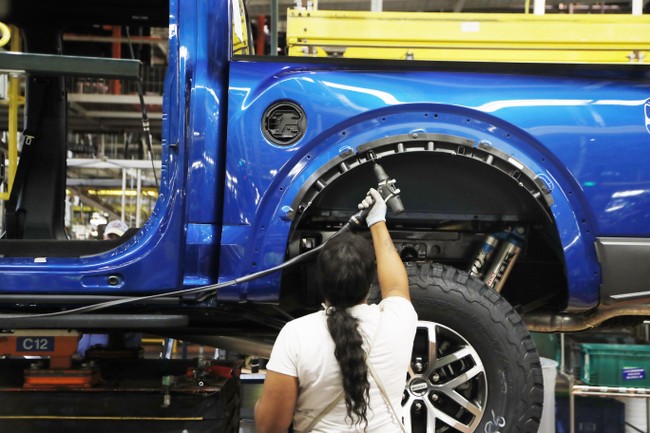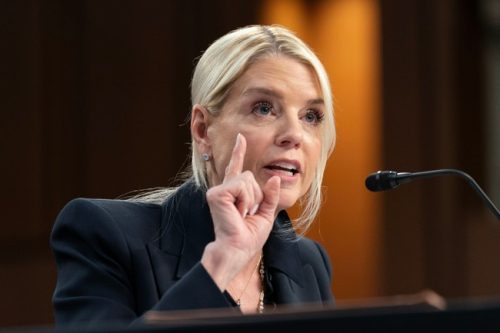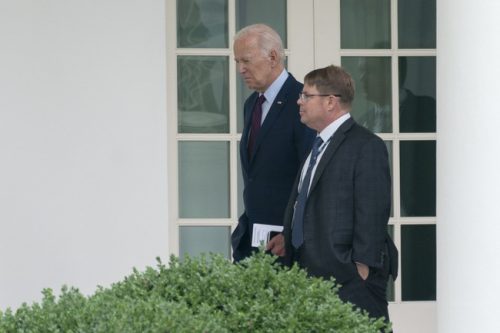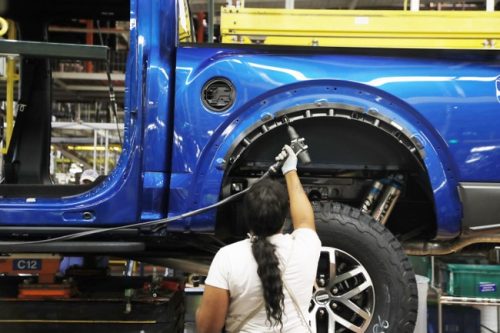President Trump says Detroit automakers have been calling to thank him for tariffs on mid-size and large trucks, and the debate over those tariffs is shaping investments, jobs, and political lines across Michigan and the broader Rust Belt.
Automaker leaders in Detroit reportedly reached out to convey appreciation after tariffs were applied to mid-size and large trucks, crediting the policy with strengthening domestic manufacturing incentives. That reaction is a political win for a Republican approach that puts American production first and pushes companies to build here. These calls land against three decades of manufacturing decline that still haunts Michigan towns.
Over 30 years, Michigan has lost over 287,000 manufacturing jobs, according to data from the St. Louis Federal Reserve. That loss left communities hollowed out and families with fewer good-paying options, which is why policies designed to bring production back matter so much. The tariffs aim to change incentives, and business responses suggest they are moving the needle.
Trump posted on social media:
The state’s overall employment picture tells the same story: Michigan’s workforce dropped from 881,900 jobs in 1999 to 594,600 jobs as of January 2025, according to data from the Federal Reserve. Those numbers show the depth of the problem and explain why political pressure to act has grown. When production leaves, communities pay the price for generations.
Domestic carmakers have faced stiff competition from overseas companies like Toyota and Honda, and that pressure has pushed many decisions to foreign plants and Southern states. The Big Three automakers in Detroit are Ford, GM, and Stellantis, which owns Jeep, RAM, Chrysler, and Dodge. For years, the argument has been that market forces alone wouldn’t rebalance those incentives fast enough.
Ford Motor Company and General Motors haven’t responded to requests for comment, and the silence keeps the focus on what policymakers can do. Business leaders’ private signals matter more than media sound bites when it comes to investment decisions. That’s why a policy tweak that nudges manufacturers back to U.S. plants is getting notice.
🚨 JUST IN: The top executives of automakers GM and Ford just SHOCKED the experts by personally calling President Trump and THANKING him for the tariffs
Wow — I was told these would cause a Great Depression!
“Mary Barra of General Motors, and Bill Ford of Ford Motor Company,… pic.twitter.com/QOc9dhSwf3
— Eric Daugherty (@EricLDaugh) October 22, 2025
Stellantis recently announced it will invest $13 billion in U.S. manufacturing over the next four years, planning to expand production capacity by roughly 50 percent using plants in Illinois, Indiana, Ohio, and Michigan. Those commitments are the kind of private-sector follow-through conservatives want to see after policy changes. Investment at that scale creates jobs across supply chains, from parts suppliers to local services.
The tariffs are pitched as a way to raise the cost of imported vehicles and parts, nudging companies toward domestic factories and American workers. In August, the Congressional Budget Office estimated that Trump’s tariffs will cut $4 trillion from the national deficit if continued. Whether that full estimate holds up, the message is clear: tariffs are intended to shift economic incentives back toward the United States.
Detroit literally put the world on wheels, but many assembly lines moved overseas or to the South where states offered cheaper electricity and other advantages. The tariff strategy is designed to reverse that trend, or at least slow it, by making imports less price-competitive. That can translate into new factory lines, rehiring, and revived local economies if companies act on the new calculus.
Critics argue tariffs will raise consumer prices and strain supply chains, and those are legitimate concerns that deserve scrutiny. Michigan Governor Gretchen Whitmer has been skeptical, saying tariffs harm middle-class families and complicate regional industry ties. Her remarks have become a focal point for the opposing view on trade tools.
“Tariffs are putting the middle class in a tough spot,” Whitmer said. “I’ve been very clear that I’m not opposed to tariffs outright, but we can’t treat them like a ‘one size fits all’ solution . . . Swinging the tariff hammer hurts us both, damaging supply chains, slowing production lines, and cutting jobs on both sides of the border.”
When asked what she would do differently, the governor dodged the question. That dodge has given critics political cover to argue that Democrats talk a lot about jobs but struggle when it comes to offering actionable alternatives. Meanwhile, business commitments and local hiring are what voters actually see in their towns.
For conservatives who back the tariffs, the key point is simple: policy should create stronger incentives for companies to build and hire in America. If a tariff nudges a major automaker to expand a plant in Michigan instead of abroad, that is immediate and tangible progress. The political fight then becomes a debate over whether short-term price impacts are worth long-term industrial revival.
Local leaders and union officials will watch whether announced investments actually lead to sustained hiring and supplier growth. A one-time announcement is useful, but follow-through across years is what rebuilds communities. The stakes are high, because manufacturing jobs support families and local tax bases in ways many service-sector jobs do not.
Tariffs are a blunt instrument, but supporters argue blunt tools sometimes cut through entrenched incentives that market nudges won’t. The Detroit response shows industry is listening when policy changes the math of where to build. If those calls from automaker executives turn into real jobs on the ground, the political argument for tariffs gains weight.
The debate is far from over, but the mix of federal policy, private investment commitments, and state-level reactions will shape whether the Rust Belt regains strength. Voters in manufacturing states will be watching whether Washington’s moves translate into reopened plants and fuller paychecks. In the meantime, the story of tariffs, jobs, and investment will keep driving headlines and political arguments across the region.






